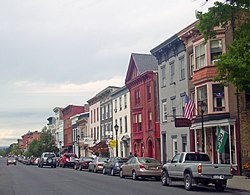Hudson Historic District | |
 View west along Warren Street from South Fourth, 2008 | |
| Location | Hudson, NY |
|---|---|
| Coordinates | 42°15′04″N 73°47′19″W / 42.25111°N 73.78861°W |
| Area | 139 acres (56 ha)[1] |
| Built | 1783–1935[1] |
| Architectural style | Various 19th- and 20th-century styles |
| MPS | Hudson MRA |
| NRHP reference No. | 85003363 |
| Added to NRHP | 1985 |
The Hudson Historic District includes most of downtown Hudson, New York, United States, once called "one of the richest dictionaries of architectural history in New York State".[2] It is a 139-acre (56 ha) area stretching from the city's waterfront on the east bank of the Hudson River to almost its eastern boundary, with a core area of 45 blocks. It has 756 contributing properties, most of which date from the city's founding in 1785 to the mid-1930s. In 1985 it was listed on the National Register of Historic Places.
It includes part of Hudson's original Front Street-Parade Hill-Lower Warren Street Historic District, excluding portions which were demolished soon after that district was designated in 1970. It is one of the rare downtowns to have followed the grid plan laid out by its 18th-century founders through the present day, and Warren Street, its main artery, is New York's most intact 19th-century main commercial street.
The oldest buildings in the district reflect the city's post-Revolutionary origins as a safe harbor for New England whalers, a past alluded to today by the whales on the street signs. It later became an industrial center, with areas of worker housing and grand homes of factory owners in its downtown. In the early 20th century, the rise of officially-tolerated prostitution on what is today Columbia Street made the city known as "the little town with the big red-light district."[3]
Historic preservation efforts since the district's establishment have helped spur the city's economic renewal. Shortly after the district was designated, antiques dealers began setting up shops on Warren Street, leading eventually to what The New York Times described as "the best antiques shopping in the Northeast". Art galleries followed, and many weekend visitors have relocated to Hudson full-time, including some celebrities. The new arrivals have restored old houses they have purchased.[4][5] The city has established a Historic Preservation Commission to protect the district's historic character.[2]
- ^ a b Dunn, Shirley (August 1985). "National Register of Historic Places nomination, Hudson Historic District". New York State Office of Parks, Recreation and Historic Preservation. Archived from the original on June 4, 2012. Retrieved June 22, 2009.. A partial version is at livingplaces.com, which does not require JavaScript.
- ^ a b "City of Hudson: Historic Preservation". City of Hudson. February 2007. Archived from the original on June 11, 2009. Retrieved June 23, 2009.
- ^ Faber, Harold (October 21, 1994). "Hudson Casts New Light on Its Red-Light Past". The New York Times. Retrieved June 25, 2009.
- ^ Matthews, Kathryn (November 11, 2001). "HAVENS; Weekender – Hudson, N.Y." The New York Times. Retrieved June 23, 2009.
- ^ Hughes, C.J. (November 3, 2006). "Hudson, N.Y.; Architectural Gems In an Antique Setting". The New York Times. Retrieved June 24, 2009.

